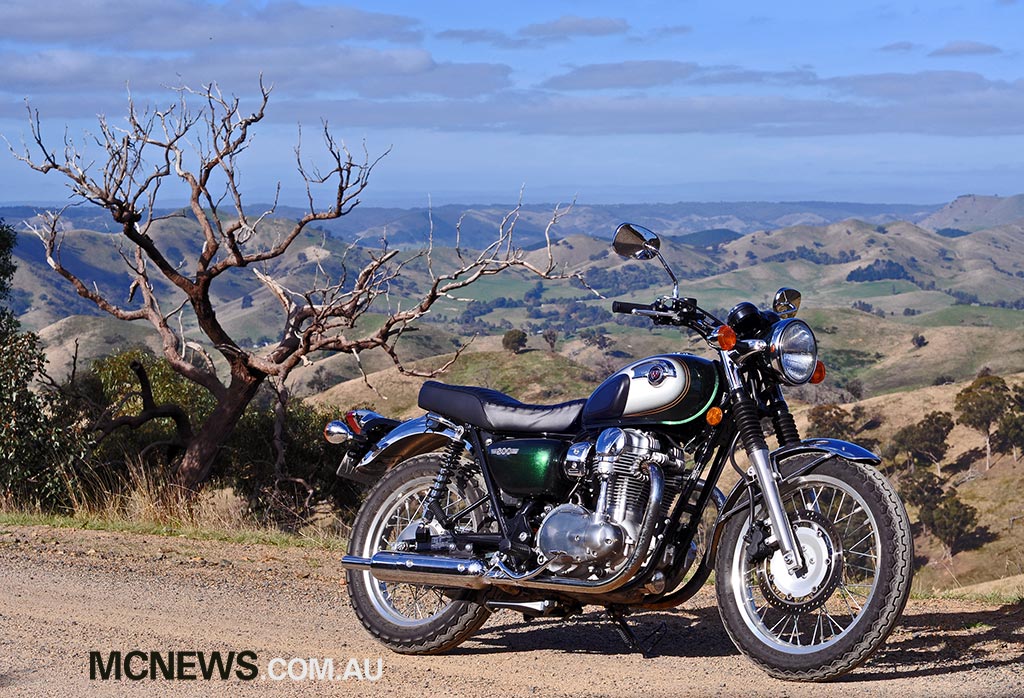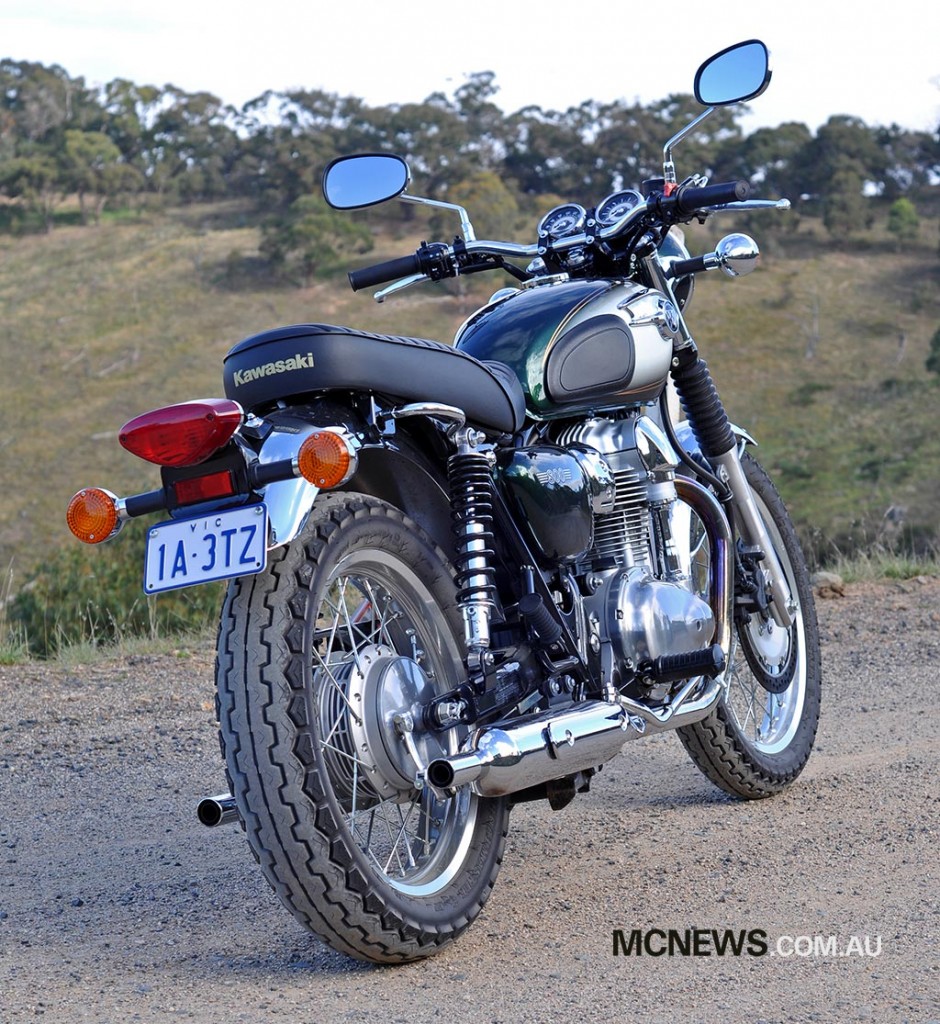Kawasaki W800 Review – By Trevor Hedge
Kawasaki were the first of the Japanese brands to go seriously retro with their W650 more than a decade ago. Despite this, Triumph’s modern day Bonneville (also largely manufactured in Asia) had more cred’ with the buying public, thanks to that British brand name on the tank. The Triumph was also the more appealing ride, having improved and changed over the years, while the W650 remained the same.
In 2011, thanks to a 5mm larger bore, Kawasaki have reinvented their machine and the W650 has grown to become the W800 and this time around Triumph should definitely sit up and take notice.
Retro-chic is all about the look and the W800 is a truly stunning machine. The attention to detail on this bike is really a class above the competition. The chrome rims with their beefy spokes, the authentic lighting, saddle and streamlined tank, all ooze class. The W650 did a reasonable job in this regard but the W800 has stepped it up another few notches.
It is only upon close inspection of details like the switchgear and small LCD gauge inside the instruments, that you actually realise that this is not the real deal from the 1960s. And you certainly don’t have to be of that vintage to appreciate this classic styling – I certainly am not! You get the style without the kick-starting or oil leaks.
The vertical side-by-side twin certainly looks the part with the bevel-drive cam a particular masterstroke of the stylists. Despite a 360-degree crankshaft and heavy flywheel the rider is largely isolated from what’s going on beneath them, which is a little disappointing. Nothing a set of rorty pipes wouldn’t fix though.
Developing maximum torque from as low as 2000rpm, there is no real benefit in revving the fuel-injected mill too hard. It revs cleanly to 7000rpm but the best grunt is available between 3000 and 5000rpm.
Acceleration off the line is a little sluggish but once up and running the W800 responds okay. There is no real feeling of significant thrust as the engine is just so incredibly smooth. Expect to be surprised, however, when you look at the speedo. Top gear roll on from 60km/h or 100km/h is actually quite respectable and a downshift is rarely needed to accomplish a swift overtaking manoeuvre. Its pull is deceptive.
The fuel tank holds a modest 14 litres, but the W800 easily betters 20km per litre which gives the Kawasaki a 280km range.
The spring rates in the twin shock rear end are quite soft but the damping does a reasonable job of keeping it from bouncing too much over bumps. One up it is passable, but if carrying a pillion I really think some stiffer springs will be in order. Again, that’s quite an easy fix and if you really enjoy pushing through corners then throw in a set of stiffer springs in the 39mm forks while you are at it.
Sporting prowess in the hills is not really the design brief for the W800. Although it is much better in the hills than virtually any cruiser style motorcycle you care to name. The skinny rubber helps make the W800 feel very athletic when sweeping smoothly from bend to bend and as long as you attune to its limitations it still offers a fun ride in the hills. There’s no pressure riding a bike like this, you just pick your pace and rock your socks off along your favourite riding route. It’s not quite as competent in the hills as the Triumph iterations on this theme, but it’s still good fun and you don’t really care.
The single disc front end has no ABS, nor any need for ABS, as there isn’t enough stopping power to lock the front. The forks couldn’t cope with serious stopping power anyway and again it’s a horses-for-courses scenario. I think some female riders would appreciate less effort being required at the lever though and a little more braking power would be welcome.
This style of bike is perfect for a Sunday cruise out for lunch and would additionally make a fantastic commuter. The W800s easy going nature, smooth engine and low seat height makes for a ripper bike around town. It is certainly worth serious consideration amongst buyers that are after something with plenty of style but endowed with handling dynamics far superior to the vast majority of cruiser style motorcycles. And for a fraction of the price.
At $11,999 plus on roads is a little dearer than the base model Bonneville from Triumph but it is $1500 cheaper than the Bonneville SE. The clincher is that the Kawasaki is a more authentic retro experience than the Triumph, but for some it won’t matter how good it is if it doesn’t have that Triumph badge on the tank. Unfortunately for Kawasaki, that’s just how it is.

Specs – Kawasaki W800
- Engine – 773cc, air-cooled, vertical-twin
- Bore x Stroke – 77 x 83mm
- Compression Ratio – 8.4:1
- Induction – EFI 34mm
- Transmission – Five speed, chain final drive
- Tyres – 100/90-19 (F), 130/80-18 (R)
- Brakes – 300mm disc with twin-piston caliper (F), 160mm drum (R)
- Seat Height – 790
- Wet Weight – 216kg
- Rake – 27 degrees
- Trail – 108mm
- LxWxH – 2180 x 790 x 1075mm
- Wheelbase – 1465mm
- Ground Clearance – 125mm
- Fuel Capacity – 14 Litres
- Average Consumption on test – 5 litres per 100km
- Range – 280km
- Warranty – Two years
- Price – Expect to pay around $11,999 plus applicable stamp duties and registration charges

Verdict – ****
Positives
- + Finish
- + Looks
- + Economy
Negatives
- – A bit soft
- – Needs some noise























